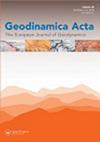Regional thermo-rheological field related to granite emplacement in the upper crust: implications for the Larderello area (Tuscany, Italy)
IF 1.5
Q1 Earth and Planetary Sciences
引用次数: 13
Abstract
ABSTRACT We modelled thermo-rheological perturbations, related to the emplacement of a magmatic body in the upper crust. This approach was considered relevant for the areas characterized by elevated surface heat flow and chiefly for the geothermal fields. The numerical conductive thermal model applied to the Larderello geothermal area in Tuscany, allowed to constrain size, depth and timing of emplacement of the pluton. We inferred that the emplacement of a magmatic body, at a minimum depth of 3 km, having a horizontal extension of 14 km and a maximum thickness of 8 km, can reasonably reproduce the observed regional surface heat flow anomaly of the Larderello area, when 300 (± 100) kyr are elapsed from the magma emplacement. Even assuming an incremental growth, the first magma injection should not be older than 1 ± 0.3 Ma. Results of the thermal model were used to set up a rheological model and to simulate the drifting of the brittle-ductile transition during the cooling of the pluton. A comparison with the K-horizon profile, a prominent seismic reflector in the Larderello area, was then performed. It was found that the K-horizon approximately corresponds with the pluton roof and with the current location of the brittle-ductile transition.与上地壳花岗岩侵位有关的区域热流变场:对Larderello地区(意大利托斯卡纳)的影响
摘要:我们模拟了与上地壳岩浆体侵位有关的热流变扰动。这种方法被认为与地表热流升高的地区有关,主要与地热田有关。数值传导热模型应用于托斯卡纳的Larderello地热区,可以限制深成岩体的大小、深度和侵位时间。我们推断,当岩浆侵位经过300(±100)kyr时,最小深度为3km、水平延伸14km、最大厚度为8km的岩浆体侵位可以合理地再现Larderello地区观测到的区域地表热流异常。即使假设增量增长,第一次岩浆注入也不应超过1±0.3 Ma。热模型的结果用于建立流变模型,并模拟深成岩体冷却过程中脆韧性转变的漂移。然后与Larderello地区一个突出的地震反射面K-horizon剖面进行了比较。研究发现,K层大致对应于深成岩体的顶部和脆韧性过渡的当前位置。
本文章由计算机程序翻译,如有差异,请以英文原文为准。
求助全文
约1分钟内获得全文
求助全文
来源期刊

Geodinamica Acta
地学-地球科学综合
CiteScore
4.50
自引率
0.00%
发文量
0
审稿时长
25 weeks
期刊介绍:
Geodinamica Acta provides an international and interdisciplinary forum for the publication of results of recent research dealing with both internal and external geodynamics. Its aims to promote discussion between the various disciplines that work on the dynamics of the lithosphere and hydrosphere. There are no constraints over themes, provided the main thrust of the paper relates to Earth''s internal and external geodynamics. The Journal encourages the submission of papers in all fields of earth sciences, such as biostratigraphy, geochemistry, geochronology and thermochronology, geohazards and their societal impacts, geomorphology, geophysics, glaciology, igneous and metamorphic petrology, magmatism, marine geology, metamorphism, mineral-deposits and energy resources, mineralogy, orogeny, palaeoclimatology, palaeoecology, paleoceanograpgy, palaeontology, petroleum geology, sedimentology, seismology and earthquakes, stratigraphy, structural geology, surface processes, tectonics (neoteoctonic, plate tectonics, seismo-tectonics, Active tectonics) and volcanism.
Geodinamica Acta publishes high quality, peer-reviewed original and timely scientific papers, comprehensive review articles on hot topics of current interest, rapid communications relating to a significant advance in the earth sciences with broad interest, and discussions of papers that have already appeared in recent issues of the journal. Book reviews are also included. Submitted papers must have international appeal and regional implications; they should present work that would be of interest to many different specialists. Geographic coverage is global and work on any part of the world is considered. The Journal also publishes thematic sets of papers on topical aspects of earth sciences or special issues of selected papers from conferences.
 求助内容:
求助内容: 应助结果提醒方式:
应助结果提醒方式:


